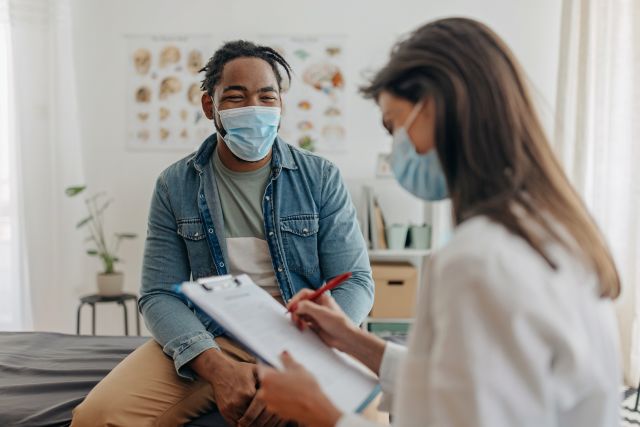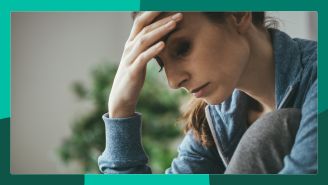Updated on September 12, 2024.
COVID is caused by a virus known as SARS-CoV-2. COVID is also sometimes called COVID-19 because the disease first emerged in 2019. It usually causes respiratory illness and can have symptoms that are similar to the flu, a cold, or pneumonia. COVID may also affect many other parts of the body.
Most people with COVID do not develop a serious infection. They may have only mild symptoms, or they may not have any noticeable signs of the disease. But some do develop severe COVID and become very sick. Death from COVID is not as common as it was during the height of the pandemic, but the disease can still be deadly in certain cases. And others—including those who only had mild infections—can have symptoms that linger for months or years after, known as “Long COVID.”
Here’s what to know about how COVID spreads, plus the latest recommendations from medical experts on how you can protect yourself, your loved ones, and your community.
How does COVID-19 spread?
COVID spreads through contaminated particles that are emitted when infected people cough, sneeze, sing, breathe, or speak. These tiny particles can waft through the air and be breathed in by others. This is known as aerosol transmission. This type of spread can occur even at distances greater than six feet. The particles from an infected person can move throughout an entire room or indoor area. They can also stay airborne in a room—even after an infected person is gone, sometimes for several hours. The risk of getting infected goes down as more time passes from when the infected person leaves the room or as the infected person moves farther away.
But the risk for aerosol transmission of COVID increases in crowded areas and spaces with poor ventilation, or closed doors or windows. This is why public health officials applied rules during the pandemic that asked people to either stay home or practice social distancing, or to stay at least six feet away from other people in public places. The measures were attempts to help reduce COVID spread.
Larger, heavier contaminated respiratory droplets caused by sneezing or coughing can also be projected through the air and land in a nearby person’s mouth, nose or eyes, or on nearby surfaces.
COVID is most often spread through the air. But if another person touches a contaminated surface, then touches their mouth, nose, or eyes, they can also become infected. The virus can remain active on surfaces for hours or even days.
Bottom line: COVID-19 is a highly contagious illness that spreads easily—not quite as easily as measles but probably more easily than the flu, according to the CDC.
How to avoid getting COVID-19
Fortunately, there are several tools you can use to protect yourself and others from illness.
Vaccination
The best way to protect yourself against severe illness from COVID is to get vaccinated. You may still be infected with COVID if you’re vaccinated, but you will be far less likely to become seriously ill, hospitalized, or die. Vaccination also helps reduce the risk of developing Long COVID.
Be sure to stay up to date with your vaccinations. The SARS-CoV-2 virus, like most viruses, changes and evolves over time into different variants that affect the human immune system in different ways. Getting updated COVID vaccines as recommended will help ensure that you stay protected from the disease.
The CDC recommends that everyone ages 6 months and older receive the latest COVID vaccines (manufactured by Moderna, Novavax, or Pfizer-BioNTech). Depending on a person’s age and health profile, there are some special recommendations:
- Children between 6 months and 4 years old should get at least one dose of the updated vaccine and may need multiple doses to stay up to date
- Children 5 years and older should get one dose of an updated vaccine
- People with moderately or severely compromised (weakened) immune systems may need multiple doses of vaccine
- Anyone 65 years or older should get a second dose of an updated vaccine around four months after their first
Hygiene
To keep others safe from respiratory illnesses, it’s important to always practice good hygiene. This includes:
- Covering your mouth and nose when you sneeze, using a tissue or your elbow
- Washing your hands frequently with soap and water or applying hand sanitizer with 60 percent or more alcohol
- Cleaning high-touch surfaces like drawer handles and doorknobs
Masks
There are certain times when masks may be useful in preventing infection. These situations include when you or someone you interact with are sick or were recently sick or exposed to a virus, or if there is an outbreak of respiratory illness in the community. Wearing a mask or asking visitors to your home to wear a mask can be an effective protective measure against infection from COVID during these times. Respiratory viruses have more difficulty spreading when masks are worn by infected people.
A mask can also protect the wearer if there are viral particles in the air around them. If you’re selecting a mask to wear, the best option is one that offers the highest level of protection while still being comfortable enough to wear. It should also fit snugly, covering both the mouth and nose completely.
Improve ventilation
COVID and other respiratory viruses can spread easily through an unventilated indoor area. Improving the ventilation in your home or workplace is an effective way to lower your risk and the risk posed to your visitors.
Opening windows and doors to get fresh air and cross breezes can keep the air moving. Standalone fan units can be used to blow air from inside to outdoors. Exhaust fans from the stove and the bathroom can also help move air from indoors to outside.
If you’re able to, you can also use a portable high-efficiency particulate air (HEPA) purifier. Be sure to choose the correct size for your room.
Choose pleated filters for your central heating, ventilation, and air conditioning (HVAC) system, as they’re more effective. Set the fan on your air conditioning or heating to “on” rather than “auto” to make sure it’s running continuously.
The CDC recommends leaving these ventilation measures in place for about an hour after visitors have left, to maximize their protective effect.
Avoid crowds
To lower your risk of exposure to the virus, avoid going unmasked to crowded places or any indoor space with others that has poor ventilation.
Just because someone does not have symptoms doesn’t mean they are not infected and contagious. People with mild or no symptoms can spread the virus unknowingly. These so-called “silent spreaders” can pass the infection on to others—even when they feel fine. So, if you’re gathering with others, particularly if there will be people who fall into at-risk categories for severe COVID, consider asking attendees to take a test before getting together. And be sure to follow other preventative precautions.
People at highest risk of severe COVID-19 include:
- Adults ages 65 ad older
- Infants younger than 6 months
- Pregnant people
- People with certain health issues such as heart disease, obesity, chronic lung disease, cancer, diabetes, and chronic kidney disease
PCR tests are the most accurate kind of COVID test, but they must be sent to a lab and can take several days to produce results. Antigen tests are quick and can be done at home, but they need to be done multiple times to get an accurate answer. If you have symptoms, you need to take two antigen tests, 48 hours apart. If you don’t have symptoms but suspect a COVID infection, it’s important to take three antigen tests, each 48 hours apart.
There are many self-tests that you can buy, and most communities have testing locations that offer free or low-cost tests.
Other ways to protect yourself
It’s also important to do what you can to stay healthy and keep your immune system strong, such as getting quality sleep, eating a healthy diet, and exercising regularly. Getting a flu shot can help protect against having multiple respiratory infections at the same time. To protect against the flu, everyone ages 6 months and older should receive a seasonal flu shot. The best time to get a flu shot is in September or October. But it’s not too late if you’re not vaccinated by the end of October. Flu season usually peaks between December and February and may last until May.
How you can prepare
Having a plan in place for how you will respond in case you, loved ones, or community members get COVID can help contain the virus and save lives. Be sure to consider anyone in your home or area who is at greater risk for severe infection and complications, including older people and those with underlying chronic health issues.
Other steps you can take:
- Make a list of local resources that can help you access information, support, medical attention or other essentials. It’s also a good idea to keep an emergency contact list, which includes family, friends, neighbors, healthcare providers (HCPs), employers and other essential phone numbers.
- Stock essential over-the-counter medications for congestion, cough, fever, and other respiratory symptoms.
- Create a "protected space" in your home that can be used to keep household members who are sick isolated from others who are not.
What to do if you might be sick
If you believe you may be infected with COVID or might have been exposed to the virus, you should take steps to isolate yourself and avoid spreading the illness to others.
If you develop signs of infection, call your HCP for advice. They may recommend testing for COVID and possibly the flu as well. Depending on your health background, they may advise you to recover at home, or they could recommend you receive antiviral treatment, which may help speed up recovery time and lessen the intensity of symptoms.







